Last May, I had the chance to leave my husband and hormonal teen daughters behind (darn!) and sail with a friend on the Rhine Getaway, one of Viking’s most popular river cruise itineraries. The plan? We’d sail on the Rhine through Germany from the gateway city of Basel, Switzerland, to Amsterdam on the Viking Hlin (pronounced “Lin”), covering four countries in eight days.
On the first night before dinner, a fellow passenger said what I was thinking: “I’ve been working very hard, and I’m looking forward to being spoiled.” As a writer perpetually on deadline who had also just completed the arduous college selection process with my 17- year-old, I could relate. I imagined leaving my laptop behind, lounging on the deck, enjoying lavish meals and cocktails and maybe using the spa. After all, cruising has that reputation and I was a newbie.
But like siblings bestowed slightly different sets of DNA, river cruising proved to be its own entity. While ocean cruises focus on the amenities of the ship, such as the pool and the fitness center, river cruises are more about the easy access the ship offers to the world’s top destinations, with the details — accommodations, destinations, food, and transfers — taken care of for you. Read on and you’ll see what I mean.
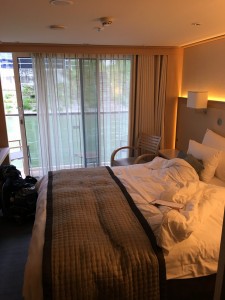
Quiet and Smooth Sailing
After setting sail in Basel that first night, the Viking Hlin traveled 60 miles at 60 miles per hour overnight to Briesach, Germany. The Hlin, a longship designed for Europe’s grand rivers rather than an ocean, was like a duck, gliding on the surface, with its four rudders and hybrid, ecofriendly electric engine working hard below to quietly propel us forward. Other than the burbling water outside my well-appointed stateroom and the passing river bank, I couldn’t tell we were moving. A heads up: On river cruises, motion sickness isn’t an issue.
At every river cruise port, Viking offers a complimentary shore excursion, such as a guided walking tour. On our first day, the freebie was a trip by motor coach (Viking’s privately-owned tour buses) to Hofgut Sternen, a tourist village known for its cuckoo clocks and Black Forest cake. On the ride, the Black Forest belied its name. It was so lush and verdant that I wondered if the famed mountainous region in southwest Germany, bordering France, needed rebranding. In May, green is the new black.
Motor coaches and river cruising go together like German beer and weinerschnitzel. When destination hot spots aren’t near a port, a motor coach gets you there. But European roads, like the one to Hofut Sternen, can be windy. If you’re prone to motion sickness, that’s where some Dramamine might come in handy.
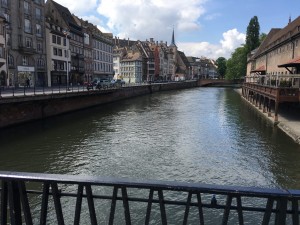
Taste the Best of Alsace
The next morning, five of us motor coached from Kehl, Germany, where the Viking Hlin had sailed overnight to Strasbourg, France, in the historic region of Alsace, which was just over the bridge and a few miles away.
In Strasbourg, we met up with Valerie, of Food and City Tours of Strasbourg, who led us on a 7-hour Alsatian walking food tour through Strasbourg’s cobblestoned streets ($150 per person). On Viking river cruise ships like the Hlin, guests can book add-on excursions. Our foodie frenzy turned out to be a cruise highlight and well worth the splurge.
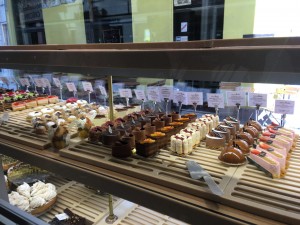
Before our first stop, Patisserie Christian, the famed chocolate shop and tearoom at the base of the Strasbourg Cathedral, Valerie relayed Strasbourg’s whiplash history through our audio listening devices (supplied by the ship). On a river cruise, be prepared to listen up. Your headset is a lifeline to the back story every curated destination has to tell.
With Valerie in our ears, we learned how the residents of Strasbourg were forced to change their nationality, including their language and customs, from French to German four times over the course of 75 years. Today, Strasbourg has a decidedly double culture, half German, half French.
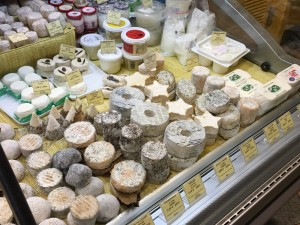
Next, we stopped by Maison Lorho, a famous Strasbourg cheese purveyor. Even before opening the door, a strong earthy smell greeted us. Maison Lorho offers 200 kinds of cheese from small French farms. Valerie informed us that the average Strasbourgian eats 24 kilos of cheese per person annually, or 52 pounds of cheese per year. (The average American eats 23 pounds of cheese per person per year.) The French eat cheese for breakfast and for dinner if they donn’t feel like cooking. Cheese is also a staple at parties. Valerie shrugged, as if to say, “Hey, it adds up!”
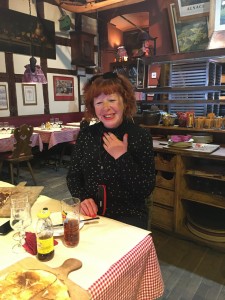
Pain D’Espices—Mireille Oster, a famous gingerbread boutique, was our next stop on the food tour. In Strasbourg, gingerbread is consumed year-round. Valerie confessed that she wouldn’t buy the spicy cookie just anywhere, especially not at commercial chain stores. Mireille Oster’s carefully crafted gingerbread featured seven spices: cinnamon, pepper, cloves, mace, cardamom, anisette, and goji berry. The delicious, earthy cookie called for espresso or a strong cup of tea.
After tasting dry and sweet Alsatian pinot noirs at a local wine shop, we sat down at a restaurant for tartes flames/ flammenkuchen, the national Sunday dinner dish of Strasbourg.
The open face tarte is made with thin bread dough traditionally topped with fromage blanc (think crème fraiche), onion and bacon and baked in minutes in a 750-degree wood-fired oven. Tartes flames is never served per person. The idea is to share. “This is mine,” Valerie says, circling her arms around her plate to emphasize her point, “is not the way.” In a restaurant, tartes flames is always ordered for the table, with a second or third tart for the group, as needed.
Sunday dinner in Strasbourg always ends with a sweet tartes flames, often made with apples. “Ooh la la,” Valerie said. (Psst! Want to try this at home? Check out Trader Joes’ Tarte D’Alsace, which is produced by Maitre Pierre, in Alsace. It’s a close cousin).
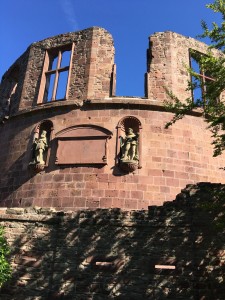
Heidelberg—College Town on Steroids
Day three brought us to Heidelberg, our next stop along the Rhine. Home to Heidelberg University (Germany’s version of Oxford University), Heidelberg is Germany’s nerd epicenter, according to Will, an American philosophy PhD graduate candidate from Arkansas, and our tour guide. Because Heidelberg wasn’t bombed during World War II, it’s a historic architecture mecca. We toured the Heidelberg castle (Schloss Heidelberg), with its grass moat and imagined the tigers that once filled it over 300 years ago.
Heidelberg castle is home to the world’s largest wine barrel, a 250-year-old vat shaped from 130 oak trees that once held 50,000 gallons of wine. In the Middle Ages, wine was safer to drink than water, Will informed us.
Later that afternoon, a group of us walked among the hilly vines at Schloss Johannisburg (Johannisburg Castle), a winery in the heart of Germany’s Rheingau region, famous for its Riesling. Because of the area’s plentiful rainfall, hot summers, and only a few extremely cold winter days, “Riesling is the perfect grape for this climate and the most important grape in all of Germany,” said Dieter Salomon, our tour guide. The area’s special microclimate produced 240,000 bottles of Riesling per year, a limited quantity.
Although Johannisburg Castle was destroyed in World World II and rebuilt into a stuccoed, California-style estate, its ancient wine cellar was spared. We toured the musty cavern and stopped for a candle-lit Riesling tasting.
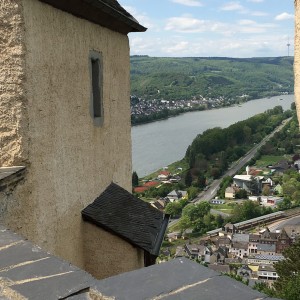
Castle Convention
Midway through our cruise, the Hlin took us on a scenic tour of the castles along the Middle Rhine, from Koblenz to Rudesheim.
It was a chilly and cloudy day on the upper deck, but Candi, our cruise director, brought the region to life with castle commentary over the loudspeaker. “Medieval noblemen built soaring castles to oversee trade, collect tolls and defend kingdoms from marauders and power seekers.”
Day five took us to Marksburg Castle, a 700-year old hilltop fortress that offered fantastic views of the Rhine Valley from its 550-foot perch.
Robert, our guide, unlocked the castle with a skeleton key, and we set out to imagine knights in armor and life in the middle ages by touring the citadel’s impressive rooftop herb garden and cavernous rooms, including its eerie torture chamber and impressive kitchen and bedrooms. The middle ages were more interesting than I had remembered. But a guided tour could turn any location into textbook-come-to-life.
“Medieval people slept sitting up so that death wouldn’t take them,” Robert said. Lying down to sleep was considered too vulnerable a position.
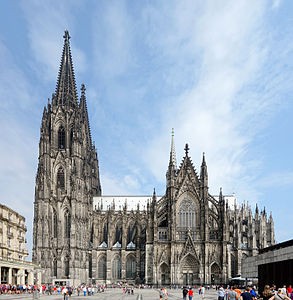
Climbing the Dom in Cologne
The next morning, we disembarked the Viking Hlin in Cologne, Germany’s oldest city. We followed Udo, our tour guide for the morning, to Cologne’s magnificent Gothic Cathedral (“Dom”), with its pointed arches, beautiful stained glass windows and two soaring spires, one deliberately higher than the other by seven centimeters “because the only perfect thing in the world is God,” Udo said.
From the ground, the Cathedral’s spires did appear close to God and impossibly pointy.
But Udo informed us that the second spire was navigable—just 533 stairs from top to bottom so I took the challenge. With all the touring and now the cathedral climb, river cruising was turning out to offer plenty of exercise. And it’s a good thing. The Hlin didn’t have a gym, pool or spa—though the top deck did sport a walking/jogging track. But who needs it when the world is your workout?
Artisanal Dutch Cheesemaking
After sailing overnight, the Viking Hlin docked in Gorinchem, The Netherlands, which turned out to be another favorite stop on the Rhine. It was an overcast day, the kind Dutch take in stride. Like rain on your wedding day bringing good luck, the Dutch have an expression to make themselves feel better: “As long as the sun is shining in your heart, the rain will stop.” Rainfall in the Netherlands averages 145 days per year.
In the birthplace of gouda (pronounced “howda”), we motor-coached through Holland’s flat, lush countryside to Booij Kaasmakers, a family artisanal, small-batch cheese farm near Rotterdam. There, we met Marika, a young cheesemaker who took over her grandmother’s cheesemaking operation. In Marika’s dining room, 10 of us sampled her award-winning gouda, from a recipe that has been in the family for generations. The hint of manure in the air was a further reminder that we were in farm country. Holland’s plentiful rainfall helps the grass grow, which keeps the milk cows happy. “The grass is why the gouda is so creamy,” Marika said.
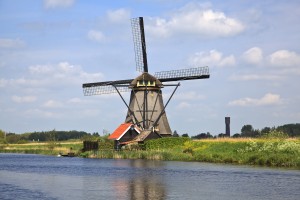
The Windmills of Kinderdijk
After a short ride on our motor coach, we found ourselves in
Kinderdijk with its 19 historic windmills, the largest group in The Netherlands. Twelve million people live on half the country, which is below sea level. In conjunction with the Delta Law, passed in 1959 to protect all Netherlands residents from floods, the windmills of Kinderdijk have an important job: to pump water from one side of the dyke to another to prevent flooding. The windmills have a 90-foot blade span and spin at a maximum of 120 miles per hour. They’re also for rent. Families live in 16 out of the 19 of them, though the wait list is a decade long!
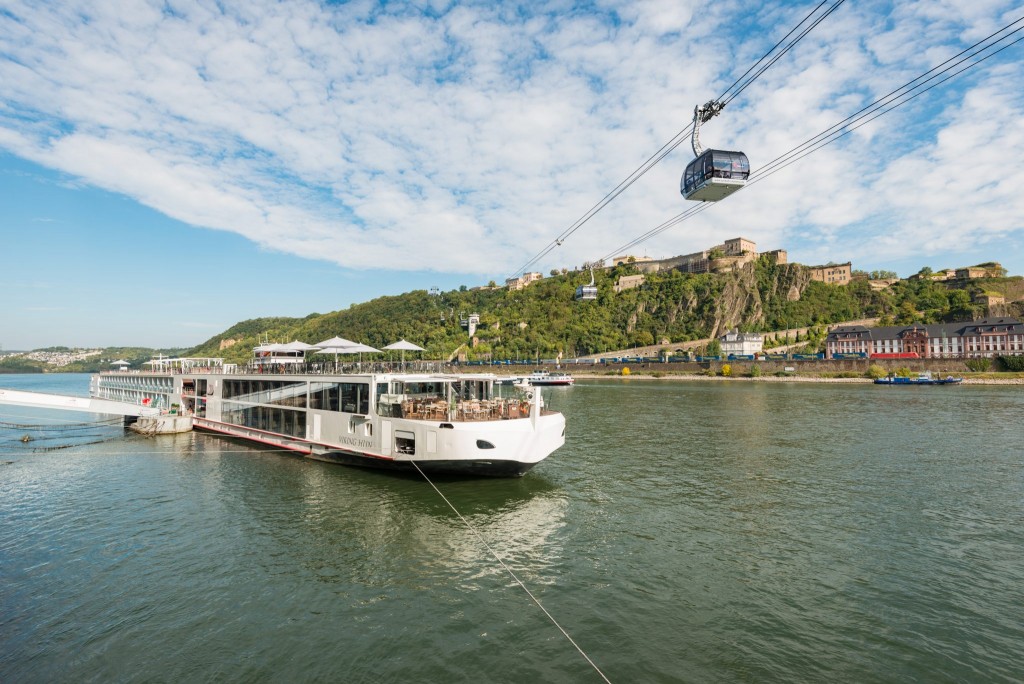
Viking River Cruise Trip Tips
Expect to learn a lot. Overall, the Rhine Getaway was more geeky than I expected. A German professor, Peter Paul Rauch, even came on board to give a lecture on German culture. (It was there that I learned that “no Germans have cuckoo clocks in their homes” and that the Ford Fusion is a popular car in Germany.)
Because I’m a nerd at heart, I enjoyed my maiden voyage much more than I anticipated. And because it a supremely convenient way to travel through Europe, we could focus on just taking it all in rather than on the trip’s logistics, such as hiring our own tour guides or getting from country to country.
Age is just a number. On the Viking Hlin, guests are typically 55 to 75. But don’t let that stop you if you’re older or younger than that, like I am. “When you share an interest in history and culture, it doesn’t matter how old you are,” said Armin Herman, the Hlin’s hotel manager.
With so much to see and do, we didn’t spend much of our free time in our staterooms, which were as upscale as you might imagine on a cruise ship. They featured a streamlined Scandinavian aesthetic and nice touches, such as a 40” flat-screen TV, Wi-Fi access, a refrigerator, hair dryer, a heated floor in the bathroom, and a hotel-style bed with luxurious linens and pillows. Viking longships are four decks high, with guest cabins on levels two and three, and hold up to 190 passengers.
Go with the flow. Even if you have a physical limitation, “we get you out there,” Herman says. On our trip, Viking ordered a taxi for a couple who wanted to see Strasbourg but couldn’t climb the steps of our motorcoach. Still, the Hlin’s bathrooms aren’t wheelchair accessible.
The cuisine was gourmet. Other than our day nibbling our way through Strasbourg, we ate our meals on board. Viking Hlin chef Mladen Arezina orchestrated meals according to Viking’s yearly menu rotation, including beautifully presented fish, meat, and vegetarian options and a taste of the local cuisine, such as a taste of Germany dinner we enjoyed, with pretzels, beer, and weinerschnitzel. They can make accommodations if you have a special diet.
The cost of the Rhine Getaway itinerary of 8 days and 4 countries on the Rhine from Basel to Amsteram started at $2,649 plus air travel. Discounts and promotions may be available at various times of the year. The Rhine River season runs from April to November. There are also holiday cruises to visit Europe’s famous Christmas markets.
Note: Sandra Gordon’s river cruise was sponsored by Viking.
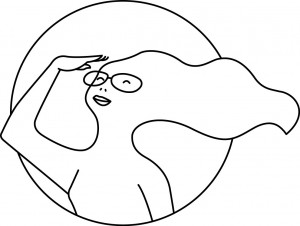
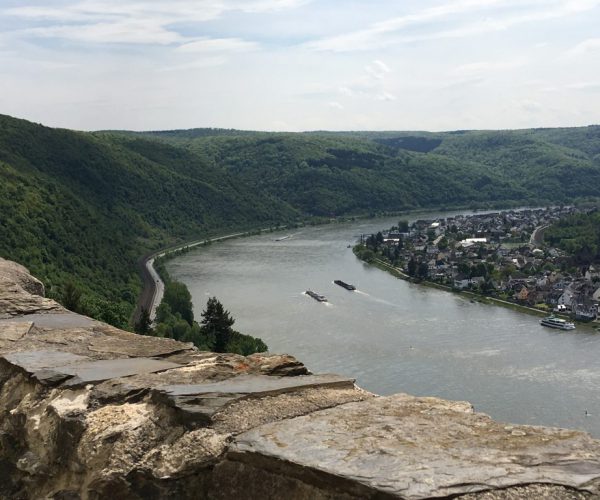
Leave a Reply